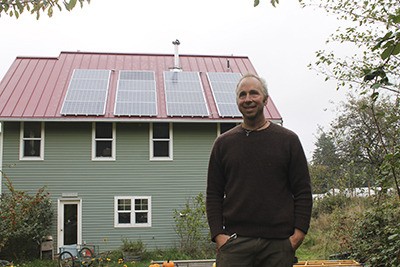When Celina and Joe Yarkin built their Maury Island home, Joe made sure the house was positioned in an ideal spot to one day hold solar panels.
Nearly a decade later, those solar panels are in place, and Celina and Joe, parents of three and well known as the owners of Sun Island Farm, are running their farm nearly entirely off the sun.
“Every time the sun is out, there’s this sensation,” Joe said standing outside his modest, two-story home last month. Atop the roof are 16 3-and-a-half by 6-foot panels that produce enough energy to power the farm’s greenhouse fans, irrigation system, well pump, coolers and freezers and electric fences, as well as an electric car used to deliver produce to CSA members.
Like most systems in the Northwest, the Yarkins’ panels produce more energy than they need in the summer, putting power back into the grid and providing energy credits they’ll use during the winter months, leading Joe to call it the “ultimate battery.”
The farm — a 3-acre swath with a large garden, fruit trees, greenhouses, chickens and pigs — would be considered “zero net energy,” if not for the fuel used by their tractor, Joe said. He believes they’re have the only small farm on Vashon with such a solar-powered operation.
“It’s a good-sized system,” he said.
Those who know the Yarkins, however, may be surprised that the couple, who moved to Vashon from New Mexico in 2001, didn’t install their solar panels sooner. Joe, an engineer, has had a career in solar energy. A contractor for the National Science Foundation, he spends months each year installing solar and wind energy systems at remote scientific outposts where no other power supply is available. For years his work frequently took him to Antarctica, though these days he mostly travels to Greenland and Alaska.
Joe says he has spent his career watching for what he calls the solar age — when the price of solar drops low enough to make the transition worth it for residential users.
As the price of solar energy systems has dropped significantly in the last 10 years — from about $5 per watt to less than $1 a watt — and agencies now offer generous incentives for solar users, Joe recently decided it was time. He spent all last summer installing the system himself with panels he purchased from a New Mexico company, a project he said any do-it-yourselfer could take on.
“It makes sense now,” he said. “The price is right, and the technology is there now.”
The 3,800-watt system would normally pay for itself in 15 years, but with Puget Sound Energy and federal incentives the Yarkins qualify for, their system will be paid off in about four years. It should last at least 25 years.
While Joe once warned people to not be too hasty in installing expensive solar energy systems, he now preaches solar, saying the industry is nearing what he calls solar parity, “when the cost of doing solar is equal to the cost of doing coal or natural gas,” he said. “It will be a historic time when it truly is there.”
Sun Island Farm, more true to its name then ever, could now be considered “off the grid,” but Joe is quick to point out that the farm is still reliant on fuel. He notes it will likely be years before they are a truly “zero energy” operation.
“This is a big step in that direction,” he said.



